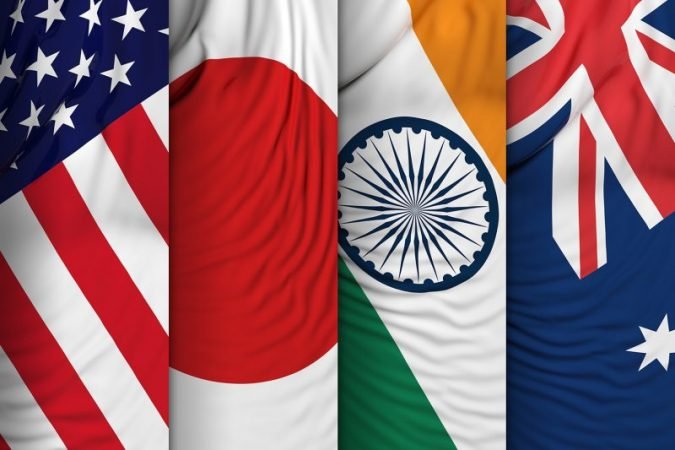Resurgence of a powerful QUAD to counter an Asian giant

Since the start of the 21st century, there has been a growing fear of an ambitious power like China developing its strategic as well as economic influence in the Asian continent and all the other countries, both regional, as well as small powers, succumbing to its overarching economic clout. The USA being a world superpower with its $21 trillion economy and a large military power with multiple fleets to protect its interest all over the world, is not able to contain the rise of China, whose economy is a $13 trillion economy and is rising alarmingly. The QUAD which is also said to be an informal quadrilateral security dialogue is a congregation of like-minded leaders of four major powers in the Indo-Pacific region, i.e. USA, Japan, Australia, and India. it is also pointed out by many scholars as a group which can become a military alliance in the Indo-Pacific region (Asian-NATO) same as that of NATO (a major military confluence of European countries with North America).

The idea of such an arrangement was first mooted by Japanese Prime Minister Shinzo Abe in 2007 in his ‘confluence of two seas’ speech providing the foundation for the grouping. But it has not yet been a full-fledged alliance as a group in its first decade of the formation until 2017. So, many questions that arise here is about what is the need for a NATO-like alliance in the region and why it has not yet been formally instituted at any level after 14 years of the dialogue. The other important question is will it need to increase its membership in the long run with its agenda being to make the region a “free and open trade in the sea” for all navigation purposes and not allowing any single entity in the region trying to own the various gateways in the region, particularly China.
The world of 2020 has changed immensely since the formation of the new world order with the disintegration of the Soviet Union, the rise of USA as the only superpower entity in the unipolar world, and the resurgence of a stealth but ever-ambitious wolf warrior in the form of China since 1991. China’s growing success in its true form has been because of its increasing economic power and also same has been its route to success in becoming an undeclared Asian giant in the geostrategic as well as the military sphere.
The reason for China being a successful economic power hub is its leadership in the global manufacturing sector and the largest contributor to the global supply chain network. The Chinese Communist Party (CCP) which holds the power in the Peoples Republic of China since 1949 has been the greatest communist regime after the demise of the Soviet Union in 1991. Though the first couple of decades was not so impressive to China’s growth in the world sphere, same as that of India’s growth, its fortune escalated upwards after it started its process of economic liberalization and opening of its domestic market for foreign investments in 1978 under the new leadership of Deng Xiaoping.
The opening up of its market to foreign companies and creating an environment for the same to open up their manufacturing base in the country with the assistance of providing cheap labour force under the strict control of centralized political power has been the mantra to its success in the country’s economic growth. The rise of China was not been particularly calculated by the theorists in the mid-twentieth century who saw China as another socialist regime which will eventually fall like USSR and will follow the path of democracy very soon. But very few would have thought that China would prefer capitalistic ideas in its socialistic beliefs and succeed without changing its communist ideology.

China with its over-arching economic growth has started creating its foothold all over the world through providing economic aids, building infrastructure projects (railroads and connectivity projects) to the poorer countries and bringing them under its debt trap. Its well-known flagship project is the Belt & Road Initiative and Maritime Silk Route that started by the Chinese President Xi Jinping in 2013, connects China with all over the world through the land as well as sea lanes of communications. It started building its navy and prepared the PLAN (People’s Liberation Army Navy) for protecting its SLOCs from external aggression against it and to put a check against anti-piracy activities in the important checkpoints of its import and export activities.
But its ambition has been to control the South China Sea region through its military power that connects the Indian Ocean with the Pacific Ocean and many external powers and regional powers have stakes in the area that carries about one- third of the global shipping (according to UNCTAD report). The Indian Ocean region has been the busiest ocean in accordance with the sea trade that happens every year and India has been a major stakeholder as well as a major security provider to this region. But China’s belief is that there should be a single power in the region and that is itself and doesn’t want India to be arch-rival to its ambitions by building its own military power to challenge the dominance of China in the region (as China dominates the region with its string of pearls theory against India by building ports and maritime infrastructures across India’s maritime borders).
Its intentions can be proved by its cordial relationship with another India’s arch-rival Pakistan and its support for cross-border terrorism into India’s territory so that most of India’s security establishments focus on the land boundaries especially the borders with Pakistan. Thus, Indian authorities will not focus on the Indian Ocean which provides the biggest stronghold against China and this strategy has proven successful for the Chinese as India is not able to shift its national security from the land boundary to the maritime boundary.

But with the advancements of India’s assertiveness in the Indian Ocean recently after early signs of Chinese aggressiveness in the region through its string of pearls theory around the Indian subcontinent has been outright and hopeful. India now willing to counter Chinese PLAN’s aggressiveness in the Indian Ocean by having regular maritime exercises with the littoral states of the Indo- Pacific region and taking initiation in creating platforms for like-minded nations in the region for dialogues and pushing to have a ‘free and open sea’ for navigation purpose. But India have to also reciprocate the believes that the ASEAN nations, in general, have in it and take a stand on the South China Sea issue.
As recently, Philippine’s Foreign Minister has welcomed India to patrol and navigate in the South China Sea. The Quad has been another platform where the stronger powers in the region can come forward to act against the one that wants to disrupt the peaceful business that happens through this region. After 2017, the group has been more proactive in having informal dialogues during the ASEAN summit. The foreign ministers of all the four nations meet at Manila to discuss the common interest and changed perspective in the Indo- Pacific Region. The initiatives like elevating the bilateral relations to the 2+2 dialogues, signing of mutual agreements like LEMOA (Logistics Exchange Memorandum of Agreement), COMCASA (Communication, Compatibility and Security Agreement), and CISMOA (Communication and Information Security Memorandum of Agreement) between India and USA, signing the same kind of mutual agreement with Australia, LSA (Logistics Support Agreement) where both can access each other’s naval facilities. The inclusion of Japan into the trilateral Malabar military exercise with India and USA has also been significant improvement and further as it seems if Australia joins the exercise in the coming year then the group will be glued further.
But until and unless there are no significant development in providing a formal shape to the institution and giving out a policy objective to the grouping, it cannot assert itself as a formidable force. It is certain that all the four democracies have a common problem and that is China though of different varieties. China’s aggressiveness has threatened the sovereignty of many littoral states in the region. It is emerging as a global power that can vehemently challenge USA’s superpower status. In the case of Australia, it is the growing influence of Chinese in Australia’s domestic policies and increasing tariff rates in its major exporting products like barley and beef in the Chinese market. Whereas, Japan (Senkaku Island) and India (Ladakh and Arunachal Pradesh region) both face a territorial dispute with China. As before, India was not sure to engage in as security or military alliance because of its policy of non- alignment, it should now rather revisit these policies that has no meaning to its national interest today and drag itself out of the non-alignment fever of the cold war era. Same with Australia which almost had three decades of mutual benefits in business with China, has to come out from the illusion that China has created to be an all-weather friend as it is clearly not that has been proved in the wake of this pandemic. So, it is prime time that the like-minded countries irrespective of the threat from China should come together and bring out a strategy to contain China. QUAD can become that platform where countries can come together and have security dialogues to maintain the status quo and have regular military exercises in the region. It may also need to increase its membership in future by bringing the ASEAN nations, South Korea and Taiwan into the mix as ‘QUAD+3’ as they too are threatened by China’s aggressive behaviour and strategy of ‘debt traps’ against weaker nations in the region.

It has been time and again proved that China is not a country to be trusted, mainly by the countries that share land or maritime borders with it. Thus, the use of collective security mechanism is the only way to counter Chinese aggression and what better platform would be for these regional powers to come together with a superpower like the USA through Quad to contain Chinese hegemonic ambition. India shares the largest land boundary with China than any other country in the group and the recent clashes in the Galwan valley against Chinese troops that killed 20 of Indian soldiers is the tipping point to India’s maintaining diplomatic relations with China and thus have larger stakes against China to be filled up. India’s relationship with the QUAD countries has been time again proved to be strong and with the mutual understanding in the group, it can succeed in containing China in the future if wisely used.


















